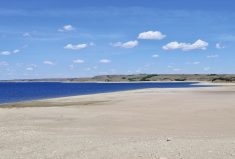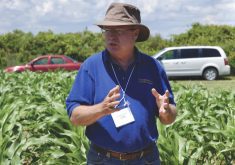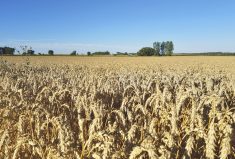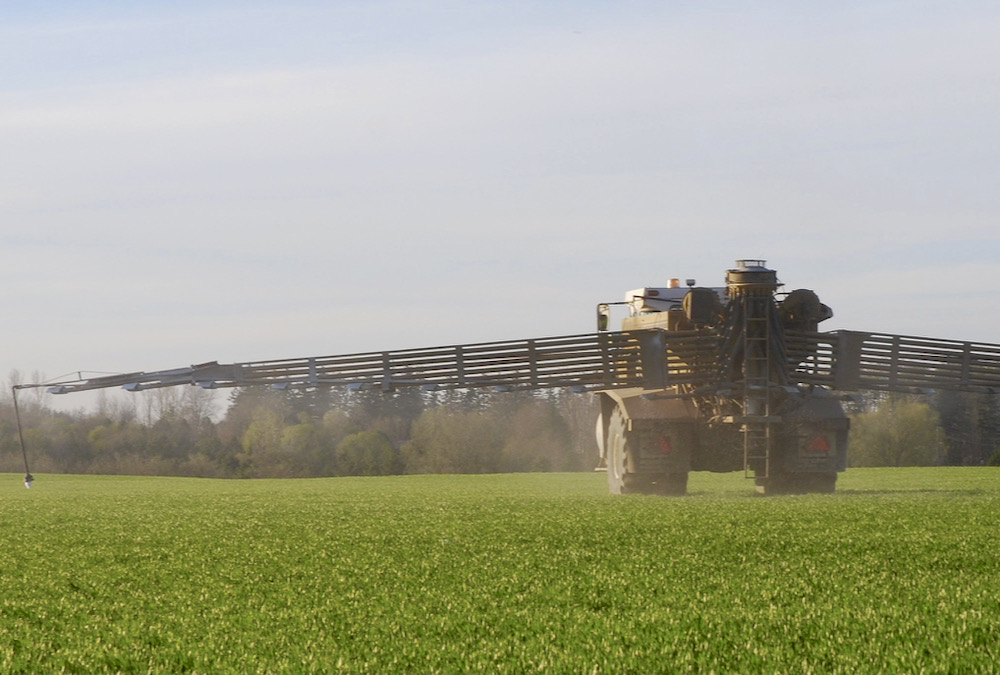When it comes to being a better farm manager, many retailers, extension personnel and researchers talk about cost of production and “controlling the controllable,” which leads to the usual factors coming up, including seed selection, soil fertility, residue management and weed control.
But the one factor that is always left off anyone’s list of controllable factors is the weather. We take what we get, and somehow do the best we can with it.
So, what if weather was added to the “controllable” list?
It may be a bit of a reach right now, given the pricing on commodity crops, land and rent prices, and the uncertainty of global markets, but under the right circumstances, subsurface drip irrigation (SDI) may become one of those investments that farmers can pencil out in order to boost their production along with their bottom line.
Granted, it’s a slow process trying to convince growers that burying irrigation lines underground is anything but a long-term commitment fraught with uncertainty in an industry that fosters more of a “farm for today” mentality. And there’s more to it than just “underground irrigation”: there are emitters and drip-lines, a filter system and pressure regulators, injectors and control valves, all adding complexity and cost. Even so, interest in the idea is growing.

Northward migration
Subsurface drip irrigation is a management practice that developed primarily in the U.S. and has moved slowly northward. In Ontario, the industry has seen its greatest increases on the sandier soils along the north shore of Lake Erie.
Todd Boughner of Judge Farms near Simcoe has had an SDI system on his farm since the 2013 growing season. Before that, he was content with corn yields of 120 bu./ac. to feed his cattle, chicken and hogs. But in 2012’s drought year, he had no crop to speak of. Once he put in his SDI system, he was harvesting upwards of 250 bu./ac.
“Our land values have gone through the roof around here, because we’re in the high-value (horticulture) region, so I figure that my best-spent dollars are for improving or recouping existing acres,” says Boughner. He was part of the trio that made a presentation on SDI at this year’s SWAC conference in January. “If we can gain something and utilize this, I’m better off than just renting it out. I’m in it for the long haul.”
Read Also

Agronomists share tips for evaluating new crop products and tech: Pt. 3
With new products, new production practices and new technology converging on the agriculture industry at a frenetic pace in recent…
Boughner considers himself something of an “open book” — ask him a question and he’ll share all he knows. His primary interest is to be a better farmer and farm manager. And he does that by studying various on-farm practices, including SDI, and making them work on his farm.
In a world that lives by the adage “hindsight is 20/20,” Boughner regrets that he didn’t travel to the U.S. to see some of the SDI systems there before he installed his own. He knows farmers and the industry in Kansas, Nebraska and other regions are in favour of SDI, especially facing considerable water-taking restrictions. At the same time, they also have access to significant grant programs to help defer costs of switching from overhead designs to subsurface.
“I’m looking ahead, because I know what’s happening to us here,” says Boughner. “Those restrictions on water are going to come up here, too. Whenever I look at any of the farms I might buy now, water and land are going to be the two big things going ahead. Everyone’s looking at it.”

That’s one of the concerns he has about any irrigation system, and he knows from conversations at SWAC and with others that it’s a concern among many people. Source-water protection, water-taking restrictions, and government-imposed flow-meters all create anxiety among growers. But he insists it’s something growers can’t be scared of because agriculture has to be proactive and part of the solution instead of worrying about the problem.
In Boughner’s relatively short experience, SDI has saved him on labour costs and provided water management with recordable, measured irrigation events, and he is focused on the timing of what the crop needs. He’s also in the field digging on a frequent basis, monitoring the progress of the system and its impact on his root structure, while also collecting on-farm weather data.
The result is that Boughner believes he’s a better farmer for the experience. He’s improved his soil health, his structure and soil organic matter levels, and overall, he’s a better corn grower — it’s a better quality product with less stress from diseases like smut, which means healthier birds and livestock. He also studies his soil more, goes to conferences and workshops, and questions his management decisions — always trying to tweak and improve the conditions. When he started with SDI in 2013, he set the goal of producing 75 more marketable bushels per year over local non-irrigated acres, and he’s doing that. In 2016, with conditions that were almost as bad as 2012, he harvested a 175 bu./ac. corn crop with SDI.
“But you have to be a part of it — you have to have that commitment,” adds Boughner. ”
Still early in the game
Another proponent of SDI and its potential is Peter White, a technician with the University of Guelph based at its research site in Simcoe. White was also at SWAC as part of the presentation on SDI and echoes many of Boughner’s sentiments about adaptability in sandier soils, considerations prior to installing and initial investments, as well as operating costs.
“I think there is interest, especially with growers on lighter sandy soils, but overall, many aren’t very familiar with subsurface drip irrigation,” says White, noting that Canadian usage of SDI is still largely in its infancy. “I believe, however, that with the weather that we had in 2012 and 2016, even farmers in areas other than the traditional tobacco belt are becoming interested and looking into it.”
From his perspective, White sees capital costs and long-term yield increases as the largest impediments to incorporating SDI, particularly in a cash crop situation. Annual operating costs are minimal but the initial outlay for installing the system can make it difficult for a farmer to pencil out. A grower who is on soils prone to compaction might find SDI to be more of a challenge. Yet White maintains that if a grower can get more than 34 per cent yield increase over a 10-year period, the investment pays for itself, and then some.
“The biggest obstacles I believe to expansion of SDI in Ontario is the initial capital cost of a well-designed system, installation of that system and the price of corn to pay for it,” says White. “We don’t have the data year-in, year-out that says on the Norfolk Sand Plain that we can get a 40 per cent yield increase on average, every year. That would pay for the system. Over the last four years, Todd Boughner has accomplished that, and that was after having no crop in 2012. We don’t yet have any long-term multiple location data, but we’re getting it.”
The other facet of “long-term” is the performance of the system. Like Boughner, White points to the SDI pioneers in the U.S., some with 20-plus years of experience with the practice. His initial thinking is that the systems installed in Ontario could last 15 years — with proper management (including maintenance). There are some designs in the U.S. that are more than 26 years old that are still running within 10 per cent of their original capacity.
Advantages
Of course, the biggest advantage, aside from increases in yield or grain quality (in the case of feeding livestock) is the addition of moisture directly and evenly into the soil. Compared to the use of an irrigation gun, SDI can save more than 50 per cent of the water (compared to an irrigation gun applying water on a sunny, hot, dry and windy day). Since water never reaches the surface, there are fewer germinating weeds and there’s less chance of fertilizer leaching, provided it’s not all applied at once. The systems also can be automated.
In fact, White is working with Rebecca Shortt from the Ontario Ministry of Agriculture, Food and Rural Affairs (OMAFRA), on a moisture sensor program where they install five representative sensors in each grower’s field. They allow the growers to monitor soil moisture near the emitter and between emitters and rows to see how irrigation is affecting the levels. One sensor is set at 36 inches below the soil surface to prevent any leaching events. The moisture sensors are then attached to a cell-style data logger that transmits data four times a day to the grower’s choice of computer, laptop or cellphone.

One of the more interesting potentials that SDI brings is the opportunity to fertigate — fertilize crops via irrigation. Much like SDI, this trend is also in its infancy among cash croppers, and more familiar among those in horticulture. White refers to it as “the ability to spoon-feed fertility to the crop if and when it’s needed.” He agrees there’s a considerable learning curve attached to the practice, but credits SDI as a solid “foot in the door” on testing and adopting it as more of a mainstream practice.
“We’re rookies at SDI but whoever installs a system like this needs to take ownership of it right from the point that you start to design it,” says White.
Much like drainage
Taking ownership is a big part of how Ray MacKenzie thinks about SDI. As a sales representative with Vanden Bussche Irrigation in Delhi, MacKenzie acknowledges the commitment needed to make SDI successful, yet before that can happen, the farmer also needs to commit to its installation.
In many ways, the investment in SDI is similar to that of installing a tile drainage system in a field — with one important difference. In tile drainage, the mapping and installation of the tiles and the mains, plus connecting everything and making sure it’s operational, is done by a contractor.
Proper design and installation is crucial with these systems. That’s why Vanden Bussche’s team GPS-maps the field and provides a CAD design, indicating the location of drip lines, headers and valves.
Then they supply the drip tape layer and train the farmer (or the farm crew) in its proper operation. Values, filters, pumps, injectors and system controls are installed by the service team, while underground headers and connections to the drop lines are installed by the farm crew with guidance from Vanden Bussche staff.
The crew will also instruct the farmer on the system’s operation and how to maintain it.
Like White and Boughner, MacKenzie also cites the capital cost as the largest barrier to moving SDI into a more mainstream setting, and it’s made all the more challenging given the stagnation of the U.S. dollar and the current low price for a bushel of corn. Yet there is significant interest from his perspective.
“We currently have eight different growers using SDI systems on grain corn,” says MacKenzie.
“The results are promising: last year with a system that was installed in 2013-14, the 2016 growing season provided the first real test. One grower who historically had 200 bu./ac. on sand had 230 and 210 averages in 2016.”
Another grower who normally yielded 230 to 250 bu./ac. was particularly hard-hit by the 2016 drought.
Yet he yielded 170 to 180 bu./ac. while many of his neighbours plowed their corn fields under.
Other challenges or disqualifiers, according to MacKenzie, include the “lay of the land.” The flatter the better is the general rule, and the less rocky the soil profile, the easier it is for installation. But just as Boughner states, this system is not “turn-key, walk-away” simple, and a grower must have a water-taking permit in advance of an SDI installation.
There’s a commitment to learning the operation of the SDI system and then maintaining it to ensure its longevity, all our sources agree.
“System maintenance is a must — flushing of the headers is important and there are acid injectors you can use to lower the pH in the fall,” says MacKenzie, citing just two considerations.
“Without proper maintenance, small particles may build up over time and reduce dripper performance. It’s also important to know whether the farmer will be rotating crops or growing corn year-after-year. Drip tape placement (typically between 40 and 60 inches) needs to be set correctly in order to make sure all rows can have access to sufficient water and nutrients.”
In the end, it’s also important for growers using SDI to irrigate every day in an effort to create consistency.
“You get a better, more uniform crop that way,” says MacKenzie, noting that an “all-at-once” deluge is never the best thing for a crop. “Too much water can be as bad as too little. Watering too much at once with any irrigation system can waste a lot of water, effectively create flooded conditions in the root zone and also cause valuable nutrients to be flushed down below the reach of the root system. You want to keep the crop in a happy place — it’s like eating three times a day for us.”
















